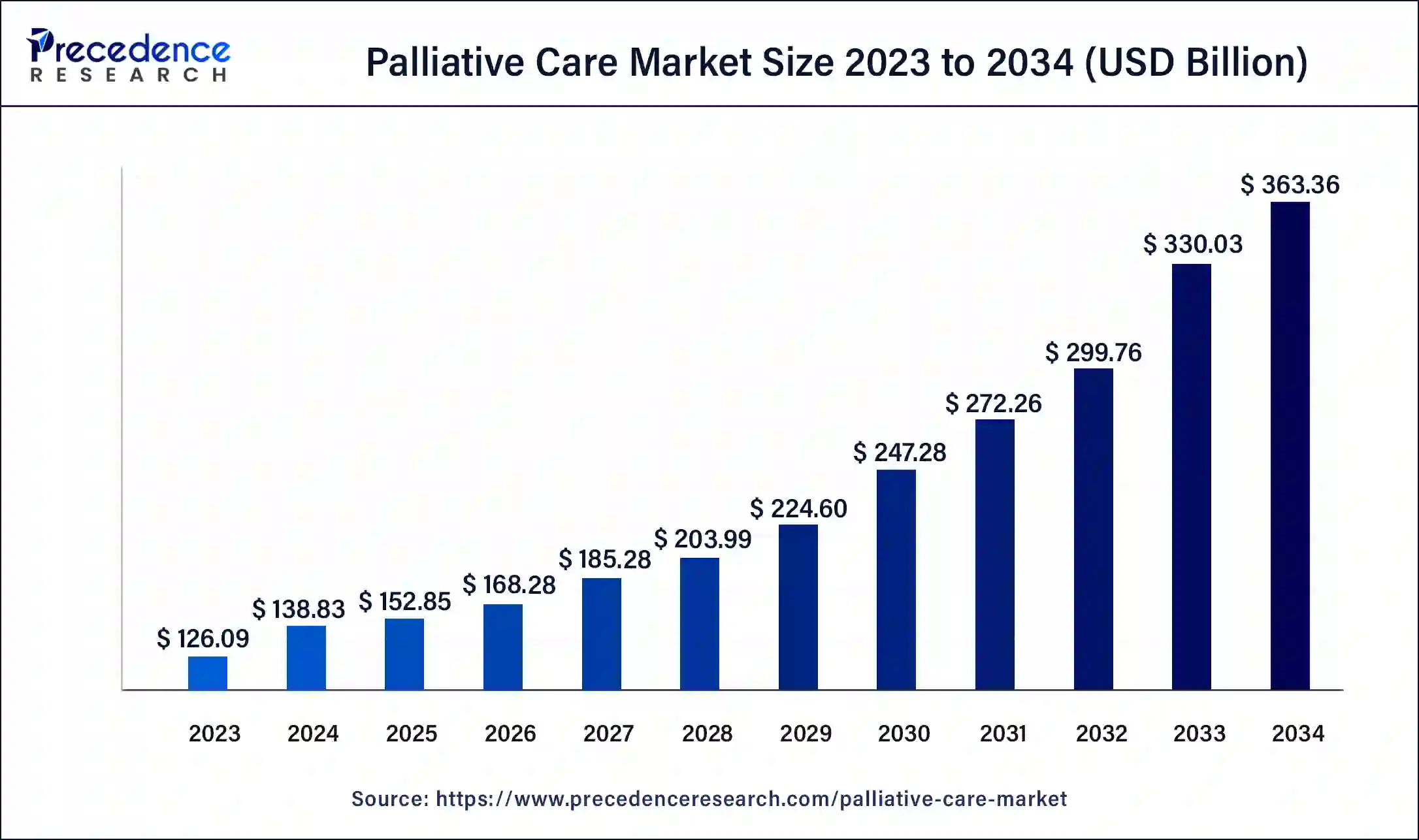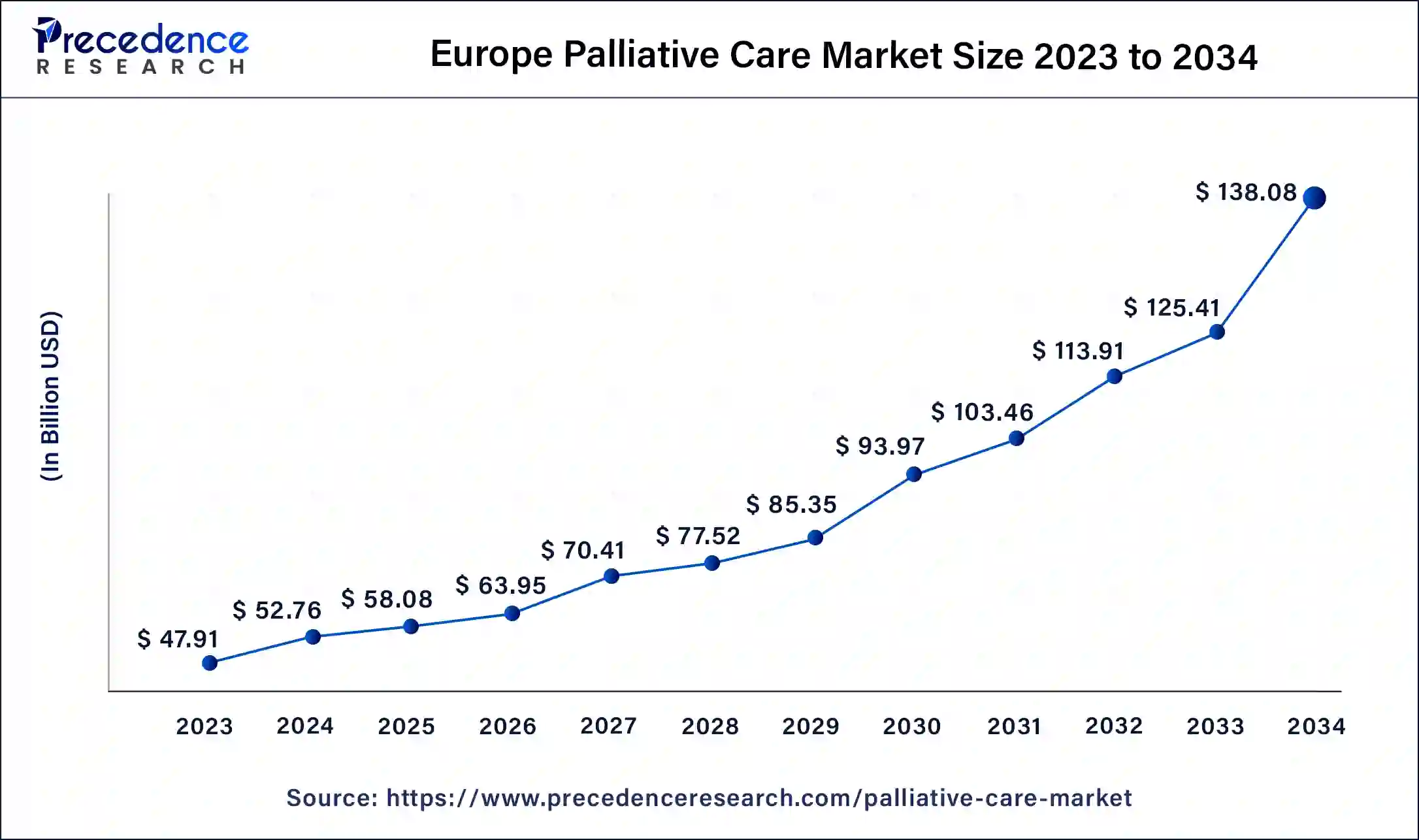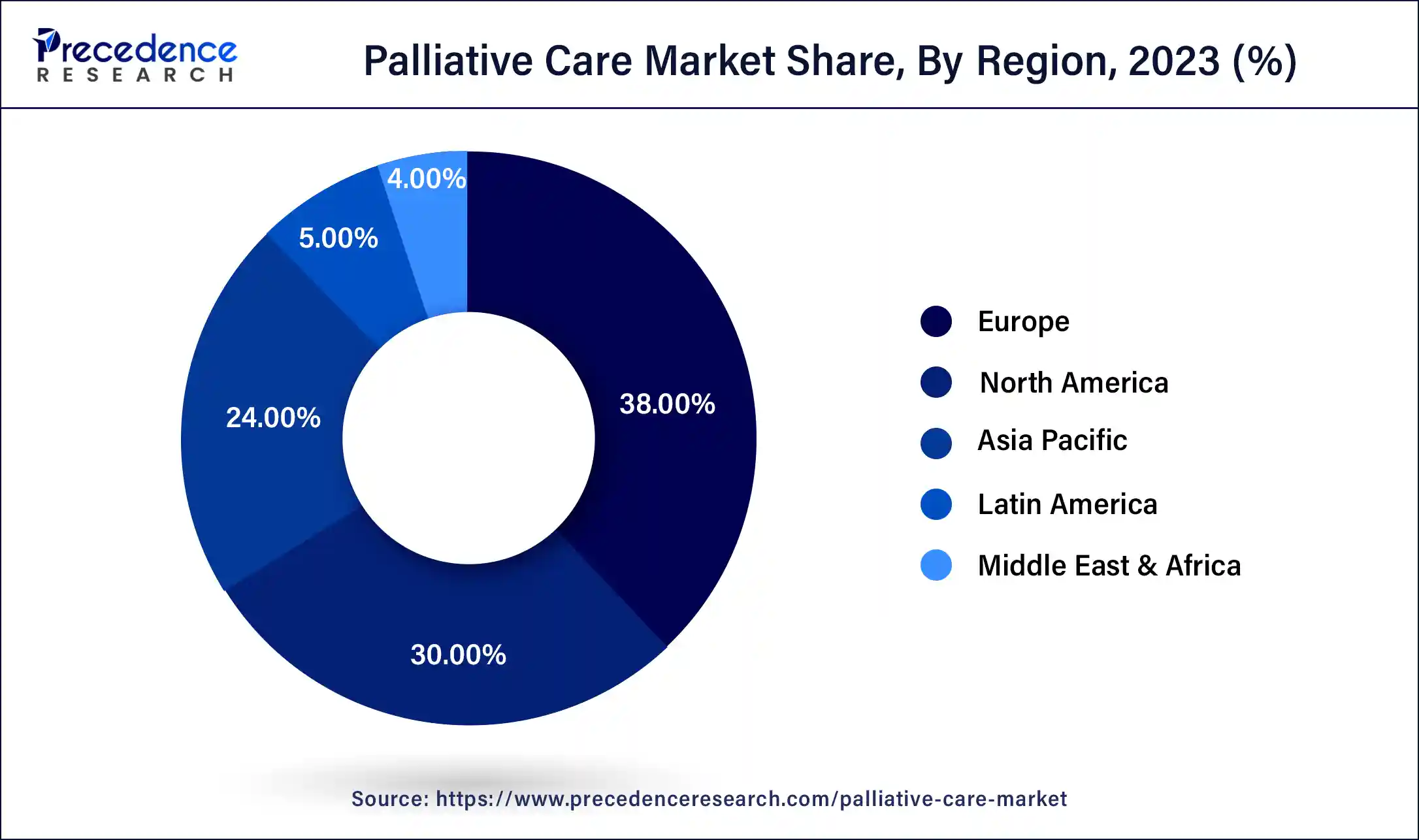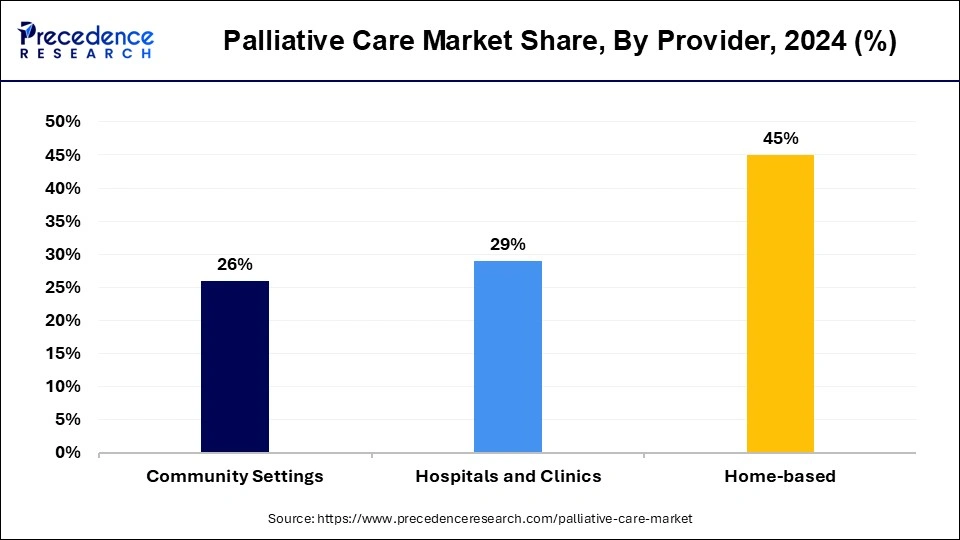List of Contents
Palliative Care Market Size and Growth 2025 to 2034
The global palliative care market size was valued at USD 138.83 billion in 2024, accounted for USD 152.85 billion in 2025, and is expected to reach around USD 363.36 billion by 2034, expanding at a CAGR of 9% from 2025 to 2034. Increasing senior population, non-communicable, communicable diseases, and other serious diseases lead to the growth of the market.

Palliative Care Market Key Takeaways
- In terms of revenue, the palliative care market is valued at USD 152.85 billion in 2025.
- It is projected to reach USD 363.36 billion by 2034.
- The palliative care market is expected to grow at a CAGR of 9% from 2025 to 2034.
- Europe dominated the market with the largest market share of 38% in 2024.
- By condition, the cancer segment has held a major market share of 37% in 2024.
- By condition, the respiratory disease segment is the fastest growing during the forecast period.
- By diagnostic group, the non-communicable diseases segment has generated the maximum market share of 69% in 2024.
- By diagnostic group, the maternal, perinatal, and nutritional conditions (MPNC) segment is the fastest growing during the forecast period.
- By age group, the adult segment led the market with the biggest market share of 52% in 2024.
- By age group, the pediatric segment is fastest growing during the forecast period.
- By provider, the home-based segment has recorded more than 45% of the market share in 2024.
- By provider, the hospitals and clinics segment is the fastest growing during the forecast period.
Europe Palliative Care Market Size and Growth 2025 to 2034
The Europe palliative care market size is estimated at USD 58.08 billion in 2025 and is predicted to be worth around USD 138.08 billion by 2034, at a CAGR of 9.2% from 2025 to 2034.

Europe held the largest share of 38% in the palliative care market in 2024.Many European countries have prioritized palliative care as an essential component of healthcare policy, with governments providing substantial funding and support for palliative care initiatives. National healthcare systems and insurance schemes often cover palliative care services, ensuring affordability and accessibility for patients and their families. European palliative care providers adopt a multidisciplinary approach to patient care, involving interdisciplinary teams of physicians, nurses, social workers, psychologists, and other healthcare professionals. This holistic approach addresses the physical, emotional, social, and spiritual needs of patients and their families, enhancing the quality of life and overall well-being of individuals receiving palliative care.
Currently, Europe is dominating the palliative care market. Europe holds a large geriatric population and a well-developed healthcare system. The patient's positive response and experience, due to the top-notch facilities from the departments and the medical staff/professionals, accelerates the demand in the market. The quick availability and service help emergency cases ensure treatment on time. The region's consideration towards patients' health has accelerated the market in the region.

North America held a notable share of the palliative care market in 2024.Palliative care may be available for everyone who needs it in any case of diagnosis, age, or region. The increasing senior population leads to the demand for hospice and palliative care in the North American region. In the United States, the palliative care field is increasing rapidly. The benefits of palliative care shown in several clinical trials are increased satisfaction, the ability to choose the place of death, less depression and anxiety, and cost-saving factors that help the growth of the market in this region. If some patient needs special services, healthcare providers may refer other specialists and providers like the Canadian Hospice Palliative Care Association, which provides hospice and palliative care services; the Government of Canada gives caregiving benefits and leaves, and Canadian Virtual Hospice gives palliative care services for the quality of life.
Asia Pacific is estimated to be the fastest-growing region during the forecast period of 2024-2034.Countries like Japan have an old population that needs palliative care due to the natural occurrence of prolonged diseases. A non-profit organization, Asia Pacific Hospice Palliative Care Network, is advancing hospice and palliative care in the Asia Pacific region. This organization aims to support patients who are suffering from life-threatening conditions.
- In March 2023, in Jammu, capacity building of palliative care was launched by the ICMR project to optimize the equality of life of the patients suffering from life-threatening illnesses.
- In February 2024, the National Healthcare Group (NHG) and Nanyang Technology University (NTU) Singapore launched a new master's program, Master of Science (MSc) in Holistic Palliative Care (HoPE), to increase national palliative care capabilities and meet urgent skilled healthcare professionals.
Market Overview
Palliative care is to improve the quality of life of patients like adults and children and their families who are facing problems with life-threatening long-term illnesses. The palliative care market deals with all required needs for palliative care, including medicines, monitoring equipment, laboratories, healthcare professionals, nurses, etc. Palliative care demand increases due to an increase in serious illnesses like chronic diseases, heart failure, neurogenerative conditions, HIV and AIDS, cancers, and multiple sclerosis. Palliative care helps improve the quality of life of seriously ill patients and comforts the families of the patients. Palliative care facilities can be in various locations like at home, hospitals, outpatient clinics, nursing homes, and assisted living facilities. Some patients take their treatments at home with the help of palliative care. Palliative care also helps to provide emotional, spiritual, and social support. It also helps to provide support and information on healthcare costs and advanced healthcare planning.
Palliative Care Market Growth Factors
- The increasing load of communicable and non-communicable diseases helps in the growth of the market.
- The increasing senior population has many serious diseases like chronic diseases, cardiovascular diseases, chronic obstructive pulmonary disease, and long-term diseases may lead to the growth of the market.
- The palliative care market provides financial, spiritual, legal, social, and decision-making support and information regarding advanced healthcare planning and healthcare costs.
- Palliative care also helps in shortening hospital stays and hospitalizations.
- These help to reduce discomfort and physical and mental distress and also help the patient to live longer, and also reduce the risk of depression.
- The market gives both the caregiver and patient improved satisfaction.
Market Scope
| Report Coverage | Details |
| Global Market Size by 2034 | USD 363.36 Billion |
| Global Market Size in 2025 | USD 152.85 Billion |
| Global Market Size in 2024 | USD 138.83 Billion |
| Growth Rate from 2025 to 2034 | CAGR of 9% |
| Largest Market | North America |
| Base Year | 2024 |
| Forecast Period | 2025 to 2034 |
| Segments Covered | Condition, Diagnostic Group, Age Group, Provider, and Region |
| Regions Covered | North America, Europe, Asia-Pacific, Latin America, and Middle East & Africa |
Market Dynamics
Drivers
Increasing risk of life-threatening illness
Palliative care has many benefits for various life-threatening conditions. Some common conditions where palliative care is helpful include cancer, chronic obstructive pulmonary disease (COPD), dementia, and cardiovascular diseases. Cancer is a common illness that needs palliative care market. Palliative cancer care is helpful depending on the type of cancer, age, prognosis, treatment, and segments. Palliative cancer care is also helpful for managing the side effects of radiation and chemotherapy and for recovering patients after surgery. It also includes treatments for depression and anxiety.
According to the World Health Organization (WHO), palliative care can be used for patients who are suffering from cardiovascular diseases. Palliative care for cardiovascular disease can help with mental health support, decision-making support, and symptom relief. Dementia is linked with a breakdown of brain functions. Palliative care may be helpful for the treatment of dementia, which causes anxiety. The market is also significant in managing a respiratory illness, chronic obstructive pulmonary disease, that causes shortness of breath and coughing. This also includes treatments for anxiety and discomfort linked with breathing difficulty.
Restraint
Limitations of palliative care
National health systems and policies rarely use palliative care facilities. Training for healthcare professionals in palliative care is non-existent or limited. Healthcare professionals' mistrust and confusion about misperceptions and terminologies. Fear in healthcare professionals of palliative care may deny life-prolonging therapies to patients. Hospital inpatients face multiple problems with accessing palliative care. Palliative care specialists are not experienced, as there is a lack of specialized knowledge for the treatment of palliative care. These factors may restrict the growth of the palliative care market. It makes the burden of decision-making and discomfort with end-of-life issues an emotional challenge, which may lead to avoidance of palliative care.
Opportunity
Enhancing knowledge about palliative care
For the market, future perspectives are health-promoting palliative care and public palliative care. It may provide directions and ideas for the development of palliative care in all sectors globally. Collaboration between healthcare and public services makes it possible to provide palliative care in the future for everyone who is in need. Strong action is required for the translation of palliative care and plans, which includes competent management, political support, and strong leadership.
Information campaigns and public education are helpful in changing public attitudes toward palliative care. Education campaigns and activities of “World Hospice and Palliative Care Day” would help to increase awareness among the people. Healthcare professionals in palliative care must be well-trained. The standards for palliative care must be developed with a large number of contributions from stakeholders to the attainment of minimum service requirements.
Technological Advancement
Technological advancements in the palliative care market feature telehealth, wearable technology, and VR/AR. The most advanced technology in the healthcare sector is telehealth. It enables easy interaction and connection between patients and medical providers. This avails facilities remotely, such as medication, consultation, and symptom management. The remote monitoring consists of wearables that track, check, and update the activities of the patient. It reflects an awareness of one's health. Wearable devices like accelerometers and actigraphs provide real-time data on patients' activities.
VR/AR technology improves communication between healthcare professionals and patients by giving a visual interpretation of treatment to the patient. This helps in connecting and sharing a basic education with the patient to build trust.
Condition Insights
The cancer segment dominated the palliative care market in 2024. Cancer treatments have side effects, and they may remain for a year even after treatment is completed. Palliative care eases the treatment side effects, and cancer treatments many people get an advantage from it. Cancer is the most common condition linked with palliative care. Palliative cancer care depends upon symptoms, type of cancer, prognosis, age, and treatment. A cancer diagnosis may get palliative care for managing the side effects of radiation, chemotherapy, and recovering patients after surgery. For treating anxiety and depression, palliative cancer care is helpful and also a helpful tool for their family members for future healthcare planning.
The respiratory disease segment is the fastest growing during the forecast period. The palliative care market may help manage respiratory diseases like chronic obstructive pulmonary disease (COPD), which causes breath shortening and coughing. Palliative care may also include treatment for anxiety and discomfort linked with breathing difficulty. Changing lifestyles, including smoking, may improve illness related to respiratory diseases; in that case, palliative care is helpful.
Diagnostic Group Insights
The non-communicable diseases segment dominated the palliative care market in 2024. Non-communicable diseases can benefit from palliated care, which is linked to health-related conditions. Non-communicable diseases include diabetes, cancers, cardiovascular diseases, and others, and these long-term diseases need palliative care. Many individuals suffer from non-communicable diseases, mainly cancers, and there is a demand for palliative care. For improving health systems, particularly non-communicable diseases, the use of palliative care has increased.
The maternal, perinatal, and nutritional conditions (MPNC) segment is the fastest growing during the forecast period. During maternal fatal conditions, palliative care is preferred. The palliative care market may help in the balancing of fatal medicine's ethical concerns. Palliative care teams help to support families and healthcare professionals or physicians in approaching goal-oriented care in maternal, neonatal, and fatal management conclusions with a fatal diagnosis. Palliative care teams can help to comfort care approaches and support termination and fatal interventions.
Perinatal palliative care introduces interrelated care plans that include obstetric and newborn care, which involve a focus on comfort for newborns and maximizing the quality of life. Perinatal palliative care may provide life-prolonging treatment. Palliative care is helpful for nutritional conditions, such as dietary advice for timely nutritional support and decreased diet-related issues. Palliative care is not only for treating or preventing nutritional conditions but also for improving comfort, quality of life, enjoyment of food, and symptom relief.
Age Group Insights
The adult segment dominated the market in 2024. Adult palliative care services increased due to the increase in diseases among this population. As the number of adult groups increases, there is an increase in chronic diseases like cancer, diabetes, cardiovascular disease, and so on that need palliative care for adults. Healthcare professionals refer to palliative care consultations for adult patients. In adult palliative care, these are patient-centered, and the relatives are involved as representatives for decision-making.
The pediatric segment is growing at the fastest rate. A classification for life-threatening diseases in different countries with different incomes is proposed by the Royal College of Pediatrics and Childcare. They may need pediatric palliative services. Pediatric palliative care is child and family centered. The number of patients who are suffering from chronic, life-limiting, and complex conditions and their family's pediatric palliative care demand increases.
Provider Insights
The home-based segment dominated the market in 2024. Home-based palliative care is a service that provides social and medical support to patients with serious conditions and their caregivers at their homes. Home-based palliative care may help caregivers and patients create plans to manage symptoms and care, make medical decisions based on values, understand the illness and prognosis, assess the need for additional help, and associate with resources. Benefits of home-based palliative care for patients, families, and health systems and its result on improved resource utilization and cost-savings. As compared to normal care, home-based palliative care lowers the cost and utilization of resources for cancer, non-cancer, high-risk elderly, COPD populations, and heart failures.

The hospitals and clinics segment is observed to be the fastest growing during the forecast period. Palliative care may be provided in the hospital setting, including professional palliative care units. Hospital-based palliative care includes palliative care units, ambulatory palliative care services, and palliative care consult teams. Outpatient clinics are committed to outpatient palliative care clinics that offer help to patients outside of hospital settings.
Palliative Care Market Companies
- Teresa Dellar Palliative Care Residence
- Amedisys
- Banksia Palliative Care Service Inc.
- Adventist Health
- Alpha Palliative Care
- Baptist Health
- Genesis HealthCare System
- Drakenstein Palliative Hospice
- Fonthill Care
- VITAS Healthcare
- Gentiva Health Services (Kindred at Home)
- Hammond Care
Recent Developments
- In May 2025, new guidance from the American Heart Association (AHA) emphasized the need to integrate palliative care into treatment plans for older heart patients. It's a relief for the geriatric population. (Source - https://www.mcknights.com)
- In May 2025, two bills, one on end-of-life and the other on palliative care, were under consideration in France's national assembly since Monday, May 12. This is a transitional change to the palliative care market. (Source - https://www.aleteia.org)
- In May 2025, Minister Paudel approved a national strategy for palliative care in Nepal 2025-2035 for patients with serious chronic illness. The aim and intention of the strategy will benefit patients and contribute to the healthcare sector. (Source - https://myrepublica.nagariknetwork.com)
- In July 2023, to improve the quality and availability for children, young people, and infants with life-threatening illnesses the Pediatric Palliative Care National Action Plan was launched by Health Portfolio Ministers of the Australian Government Department of Health and Aged Care.
- In September 2023, a new palliative care program that offers a broad range of supportive care to patients was launched by Stamford Health at Bennett Cancer Center.
- In November 2023, at UConn John Dempsey Hospital, a new inpatient palliative care program was launched.
- In March 2024, a new hospice and palliative care graduate certificate program for nurses to increase healthcare professionals in life-threatening conditions care was launched by the University of Florida (USF) Health College of Nursing.
- In March 2024, a Virtual Ward was launched by Oxford on palliative care. This is for patients who want to die at their homes and get their palliative care.
- In March 2024, the United Nations Development Program (UNDP) and the European Union partnered with the Ukrainian Ministry of Health and distributed specialized vehicles to healthcare institutions.
Segments Covered in the Report
By Condition
- Cancer
- Dementia
- HIV
- Cerebrovascular Disease
- Respiratory Disease
- Others
By Diagnostic Group
- Communicable diseases
- Non-communicable diseases
- Injury, poisoning, external causes
- Maternal, perinatal, and nutritional conditions
By Age Group
- Pediatric
- Adult
- Geriatric
By Provider
- Hospitals and Clinics
- Home-based
- Community Settings
By Region
- North America
- Europe
- Asia-Pacific
- Latin America
- Middle East and Africa
For inquiries regarding discounts, bulk purchases, or customization requests, please contact us at sales@precedenceresearch.com
Frequently Asked Questions
Ask For Sample
No cookie-cutter, only authentic analysis – take the 1st step to become a Precedence Research client